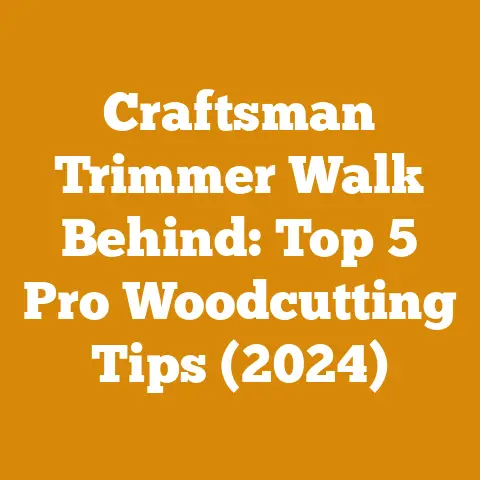Countyline Chainsaw Bar Compatibility Chart (5 Must-Know Tips)
Timeless practices in chainsaw maintenance and wood processing are essential, whether you’re felling trees in a dense forest or preparing firewood for a cozy winter. Choosing the right chainsaw bar is as crucial as selecting the right type of wood for your project. The compatibility of your chainsaw bar directly impacts the efficiency, safety, and longevity of your chainsaw.
Countyline Chainsaw Bar Compatibility Chart: 5 Must-Know Tips
Over the years, I’ve spent countless hours in the woods, dealing with everything from small-scale firewood preparation to helping manage larger logging operations. One thing that has remained consistent is the importance of understanding chainsaw bar compatibility. Using the wrong bar can lead to serious issues, including damage to the chainsaw, reduced cutting performance, and increased risk of injury. Countyline chainsaws are popular for their reliability and affordability, but ensuring you have the right bar is key. Let’s dive into the essential aspects of Countyline chainsaw bar compatibility.
Understanding Chainsaw Bar Basics
Before we get into the specifics of Countyline chainsaw bars, it’s important to understand the basic components and functions of a chainsaw bar. The bar guides the chain, supports it during cutting, and helps to lubricate the chain.
- Length: The length of the bar determines the maximum size of wood you can cut. It’s measured from the tip of the bar to where it enters the chainsaw body.
- Gauge: The gauge is the thickness of the drive links on the chain that fit into the bar groove. It must match the bar’s gauge for proper operation.
- Pitch: The pitch is the distance between any three consecutive rivets on the chain divided by two. It affects the cutting speed and smoothness.
- Mounting Pattern: The mounting pattern refers to the arrangement of the bolt holes that attach the bar to the chainsaw. This is crucial for compatibility.
I remember one time when a fellow logger tried to use a bar with the wrong gauge. The chain kept jumping off, and he ended up damaging both the chain and the bar. It was a costly mistake that could have been avoided with a little knowledge.
Tip #1: Identifying Your Countyline Chainsaw Model
The first step in ensuring chainsaw bar compatibility is to accurately identify your Countyline chainsaw model. Different models have different bar mount patterns, lengths, and chain specifications.
- Locate the Model Number: The model number is usually found on a sticker or plate on the chainsaw body, often near the engine or handle.
- Consult the Owner’s Manual: The owner’s manual provides detailed specifications for your chainsaw, including the recommended bar length, gauge, and pitch.
- Online Resources: Countyline’s website or other online resources can help you find the specifications based on your model number.
I always keep a record of my chainsaw models and their specifications in a notebook. It saves time and prevents errors when ordering replacement parts or accessories.
Tip #2: Using a Countyline Chainsaw Bar Compatibility Chart
A chainsaw bar compatibility chart is an invaluable tool for determining the correct bar for your Countyline chainsaw. These charts list various chainsaw models and the corresponding bar specifications.
- Where to Find Compatibility Charts: Countyline’s website, online retailers like Tractor Supply Co., and chainsaw parts suppliers often provide compatibility charts.
- Reading the Chart: The chart typically includes columns for the chainsaw model, bar length, gauge, pitch, and mounting pattern. Ensure all specifications match your chainsaw.
- Cross-Referencing: If you’re unsure, cross-reference the information from multiple sources to confirm compatibility.
I once relied on a compatibility chart when replacing the bar on my Countyline chainsaw after accidentally bending it. The chart helped me quickly find the right replacement, and I was back to cutting wood in no time.
Tip #3: Understanding Bar Length, Gauge, and Pitch
Bar length, gauge, and pitch are critical specifications that must match your chainsaw for safe and efficient operation.
- Bar Length: Choose a bar length appropriate for the size of wood you typically cut. A longer bar allows you to cut larger trees, but it also requires more power.
- Example: For felling trees with a diameter of 20 inches, a bar length of 20 inches or longer is recommended.
- Gauge: The gauge must match the chain’s drive link thickness. Using the wrong gauge can cause the chain to bind or come off the bar.
- Common Gauges: .050″, .058″, and .063″ are common gauges.
- Pitch: The pitch affects the cutting speed and smoothness. A smaller pitch is generally used for smaller chainsaws and smoother cuts, while a larger pitch is used for larger chainsaws and faster cuts.
- Common Pitches: 3/8″ and .325″ are common pitches.
I’ve found that using the correct gauge and pitch not only improves cutting performance but also extends the life of the chain and bar.
Tip #4: Identifying the Bar Mounting Pattern
The bar mounting pattern is the arrangement of the bolt holes that attach the bar to the chainsaw. This is perhaps the most critical aspect of compatibility.
- Measuring the Mounting Pattern: Measure the distance between the bolt holes and the diameter of the center hole.
- Comparing to Specifications: Compare your measurements to the specifications listed in the compatibility chart or owner’s manual.
- Visual Inspection: Visually inspect the mounting pattern to ensure it matches the bar you intend to use.
I once spent an hour trying to force a bar with the wrong mounting pattern onto my chainsaw. It was a frustrating experience that taught me the importance of verifying the mounting pattern before attempting to install a new bar.
Tip #5: Considering Bar Types and Features
Countyline offers different types of chainsaw bars with various features to suit different cutting needs.
- Laminated Bars: These bars are made from multiple layers of steel and are suitable for general-purpose cutting.
- Solid Bars: These bars are made from a single piece of steel and are more durable than laminated bars. They are often used for heavy-duty cutting.
- Sprocket Nose Bars: These bars have a sprocket at the tip that reduces friction and improves cutting speed.
- Hardnose Bars: These bars have a hardened tip that resists wear and tear. They are often used for abrasive cutting conditions.
I prefer using a sprocket nose bar for most of my cutting tasks. The reduced friction makes the chainsaw easier to handle, and it helps to extend the life of the chain.
Maintaining Your Chainsaw Bar
Proper maintenance is essential for extending the life of your chainsaw bar and ensuring safe operation.
- Cleaning: Regularly clean the bar groove to remove sawdust and debris.
- Lubrication: Ensure the bar is properly lubricated to reduce friction and prevent overheating.
- Filing: File the bar rails to remove burrs and ensure they are square.
- Checking for Wear: Regularly inspect the bar for wear and tear, such as cracks, bends, or excessive wear on the rails.
- Bar Dressing: Use a bar dressing tool to maintain the shape and smoothness of the bar rails.
I make it a habit to clean and lubricate my chainsaw bar after each use. It only takes a few minutes, but it makes a big difference in the long run.
Choosing the Right Chain for Your Countyline Chainsaw
Selecting the right chain is just as important as choosing the right bar. The chain must match the bar’s gauge and pitch, and it should be appropriate for the type of wood you are cutting.
- Chain Types: There are different types of chains available, including full chisel, semi-chisel, and low-kickback chains.
- Full Chisel Chains: These chains have square-cornered cutters and are the fastest-cutting chains. They are best suited for clean wood and experienced users.
- Semi-Chisel Chains: These chains have rounded-corner cutters and are more durable than full chisel chains. They are suitable for a wider range of wood types.
- Low-Kickback Chains: These chains have features that reduce the risk of kickback, such as guard links or bumper drive links. They are recommended for inexperienced users.
- Matching Chain to Bar: Ensure the chain’s gauge and pitch match the bar’s specifications.
- Chain Maintenance: Regularly sharpen the chain to maintain its cutting performance.
I always recommend using a low-kickback chain, especially for beginners. Safety should always be the top priority when operating a chainsaw.
Safety Precautions When Using a Chainsaw
Operating a chainsaw can be dangerous, so it’s important to follow all safety precautions.
- Personal Protective Equipment (PPE): Always wear appropriate PPE, including a helmet, eye protection, hearing protection, gloves, chaps, and steel-toed boots.
- Safe Cutting Techniques: Use proper cutting techniques to avoid kickback and other hazards.
- Clear Work Area: Ensure the work area is clear of obstacles and bystanders.
- Regular Maintenance: Regularly inspect and maintain your chainsaw to ensure it is in good working condition.
- Training: Receive proper training on how to safely operate a chainsaw.
I’ve seen too many accidents in the woods caused by carelessness or lack of training.
Common Mistakes to Avoid
There are several common mistakes that people make when choosing and using chainsaw bars.
- Using the Wrong Bar Length: Using a bar that is too long for your chainsaw can overload the engine and reduce cutting performance.
- Ignoring the Gauge and Pitch: Using a chain with the wrong gauge or pitch can cause the chain to bind or come off the bar.
- Neglecting Maintenance: Neglecting to clean, lubricate, and file the bar can shorten its lifespan and reduce its performance.
- Over-Tightening the Chain: Over-tightening the chain can cause it to bind and wear out prematurely.
- Cutting with a Dull Chain: Cutting with a dull chain can put excessive strain on the chainsaw and increase the risk of kickback.
I learned many of these lessons the hard way, through trial and error. By avoiding these common mistakes, you can save time, money, and frustration.
Real-World Examples and Case Studies
To illustrate the importance of chainsaw bar compatibility, let’s look at a few real-world examples and case studies.
- Case Study 1: The Firewood Producer: A small-scale firewood producer was experiencing frequent chain breakages and poor cutting performance. After consulting a chainsaw expert, he discovered that he was using a chain with the wrong gauge. Switching to the correct gauge chain resolved the problem and improved his productivity.
- Case Study 2: The Tree Removal Service: A tree removal service was using laminated bars for heavy-duty cutting. The bars were wearing out quickly and frequently breaking. Switching to solid bars improved the durability and reduced the need for replacements.
- Example 1: The Homeowner: A homeowner purchased a Countyline chainsaw for occasional use around the yard. He didn’t realize that the bar needed to be lubricated regularly. As a result, the bar overheated and wore out prematurely.
- Example 2: The Logger: A logger tried to use a bar with the wrong mounting pattern. He forced it onto the chainsaw, damaging both the bar and the chainsaw.
These examples highlight the importance of understanding chainsaw bar compatibility and following proper maintenance procedures.
Advanced Techniques for Chainsaw Use
Once you have a good understanding of chainsaw bar compatibility and basic chainsaw operation, you can start to explore some advanced techniques.
- Felling Techniques: Learn proper felling techniques to safely and efficiently fell trees.
- Limbing Techniques: Learn how to safely and efficiently limb trees.
- Bucking Techniques: Learn how to buck logs into manageable lengths.
- Notching Techniques: Learn how to use notching techniques to control the direction of a tree fall.
- Using a Chainsaw Mill: Learn how to use a chainsaw mill to mill lumber from logs.
I’ve spent years honing my chainsaw skills, and I’m always learning new techniques. The more you practice, the more confident and skilled you will become.
Troubleshooting Common Chainsaw Problems
Even with proper maintenance and operation, chainsaws can sometimes experience problems. Here are some common problems and how to troubleshoot them.
- Chainsaw Won’t Start: Check the fuel, spark plug, and air filter.
- Chainsaw Runs Poorly: Check the fuel, air filter, and carburetor.
- Chain Binds or Comes Off: Check the bar gauge and pitch, and ensure the chain is properly tensioned.
- Bar Overheats: Ensure the bar is properly lubricated and the bar groove is clean.
- Chain Dull: Sharpen the chain.
I keep a basic toolkit with me whenever I’m using a chainsaw. It includes spare spark plugs, air filters, and a chain sharpening kit.
The Future of Chainsaw Technology
Chainsaw technology is constantly evolving, with new innovations aimed at improving performance, safety, and efficiency.
- Battery-Powered Chainsaws: Battery-powered chainsaws are becoming increasingly popular due to their convenience and reduced emissions.
- Automatic Chain Tensioning: Some chainsaws now feature automatic chain tensioning systems that eliminate the need for manual adjustments.
- Electronic Fuel Injection: Electronic fuel injection systems improve fuel efficiency and reduce emissions.
- Advanced Safety Features: Advanced safety features, such as chain brakes and anti-vibration systems, are becoming more common.
- Smart Chainsaws: Some chainsaws are now equipped with sensors and connectivity features that provide data on performance and maintenance needs.
I’m excited to see how chainsaw technology continues to evolve in the future. These innovations will make chainsaws safer, more efficient, and easier to use.
Conclusion
Choosing the right Countyline chainsaw bar is essential for safe and efficient wood processing. By understanding the basics of chainsaw bars, using a compatibility chart, and following proper maintenance procedures, you can ensure that your chainsaw operates at its best. Remember to always prioritize safety and never hesitate to seek advice from experienced chainsaw users or professionals.
My journey in wood processing has taught me the value of patience, precision, and respect for the tools and materials I work with. I encourage you to approach your wood processing projects with the same mindset, and I’m confident that you will achieve great results.






